Our planet has a high level of tectonic activity. In the past few decades, disastrous earthquakes have captured our attention. Notable among them, are the 2004 Sumatra-Andaman earthquake and tsunami, with an enormous rupture length of ~1,000 miles/1,600 km and a tragic death toll of over 227,000–and the 2011 Tohoku earthquake in Japan, with peak ground acceleration measured as high as an incredible three times our normal gravity (2.99 g; for comparison, at 0.02 g, people lose their balance).
A careful look at historical records, however, demonstrates that a major volcanic eruption would cause immensely more devastation that any natural event our world has experienced recently. The January 15,2022 Hunga Tonga eruption has highlighted this hazard.
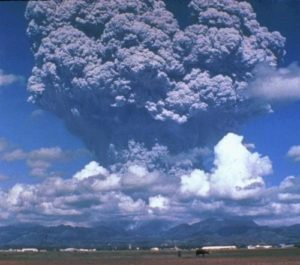
Mount Pinatubo eruption on June 12, 1991 (D. Harlow, USGS/Wikipedia)
Disruptions have far-reaching consequences in our complex world. We are more interconnected that ever before in world history. The global pandemic, as just a single example, threatens the livelihoods of millions of people worldwide, not to mention supply chains that provide everything from paper products to essential medical equipment. And nothing can cause disruptions to society that are as serious as a volcano.
On the Volcano Café website (one of my favorite blogs), the writer Tallis just published a post about the potential for extremely large volcanic eruptions. He writes: “We haven’t even come close to seeing the worst-case scenario for eruptions, in fact, we haven’t seen a truly bad case scenario for volcanoes! Think back to all of the most deadly eruptions of the past 100 years, all of those eruptions were 100s, 1,000s, 10,000s, or even 100,000s of times smaller than some of the larger eruptions in recent geological history…. Massive eruptions are much more common than previously assumed… (Many) People also don’t understand just how high the chances are for a destructive eruption and just how many volcanoes threaten millions. A massive volcanic eruption is infinitely more likely than an asteroid impact, Gamma-ray burst, or other frequently talked about global disaster…”.
Gulp. Scary!
The title of Tallis’ post is What Would Make a VSI 12? and he lists 16 active volcanoes that could be candidates for such a catastrophic eruption. These are found in Japan, El Salvador, Nicaragua, Mexico, Italy, Greece, Ethiopia, and more. He notes that all the volcanoes on his list can threaten millions of people with a VSI 6. Yikes!
Now, a few words about intensity scales, which can be confusing. The scale Albert is writing about–Volcanic Societal Impact, or VSI–is focused solely on direct volcanic impacts, including lahars, tsunamis, shock waves, pyroclastic flows, and others (indirect impacts, such as changes in climate, are not considered). The VSI scale is distinct from the VEI scale, or Volcanic Explosivity Index, that I describe in my post: A Few Facts: Volcanic Explosions. For what we are considering here, we can simply assume BIG is BAD, and you can get a sense of the magnitude of various eruptions from the following diagram without considering too many details. (This diagram was also in my VEI post – and if you want more info about some eruptions shown, I’ve described many in previous posts.)
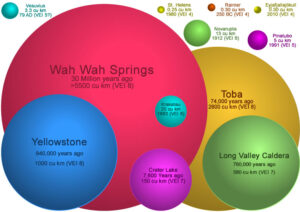
Volcano Explosivity Index (VEI)
The 1991 Pinatubo eruption in the Philippines, shown in the right upper corner of the diagram, has been rated a VEI 5 or 6 and a VSI 5.5. In that eruption, the US Geological Survey, working with the Philippine Institute of Volcanology and Seismology, managed to broadcast timely alerts about the imminent eruption. Tens of thousands of people evacuated, and the death toll of over 800, while tragic, was far lower than it would have been without the evacuations.
“Peachy bias” is a new term about human nature that Albert introduces. I think it is quite clever, although definitely in a macabre way. Albert writes, “It’s human nature to dismiss events that seem unlikely to happen and people believe in comforting thoughts and thinking about future catastrophes isn’t a comforting thought for most people. Peachy Bias has cost the lives of hundreds of millions…”
Very sad, but true.
Preparation is the key to avoiding the worst consequences of a major disruption. (Years ago, as you may remember, people were warning of a global pandemic…. oh well.) Predictions about future earthquakes and volcanic eruptions are tricky–if the event doesn’t happen, then people become cynical and may ignore future warnings that turn out to be accurate. However, being prepared–with monitoring, education, evacuation plans, and many other approaches – is all we can do. The US Geological Survey is well placed to help and is actively involved. In a program called the Volcano Disaster Assistance Program (VDAP), USGS provides crisis response, supports infrastructure development with monitoring networks, and trains counterparts to help countries establish and/or enhance their own preparation for future volcano crises. More info is here: https://volcanoes.usgs.gov/vdap/how.html .
We are always learning more–and often scarier–information about our world. And ignorance is NOT bliss (despite what Thomas Gray wrote in his poem in 1743). Only when we face facts do we have a chance of being ready for those events that we hope will never happen, but history tells us they could.
“By failing to prepare, you are already preparing to fail”
Benjamin Franklin
If you liked this post, please share it and/or leave a comment below – thanks! And if you’d like to recieve a message when I publish a new post, scroll down to the bottom of this page and leave your email address on my website. Join now to learn more about geology, geography, culture, and history.
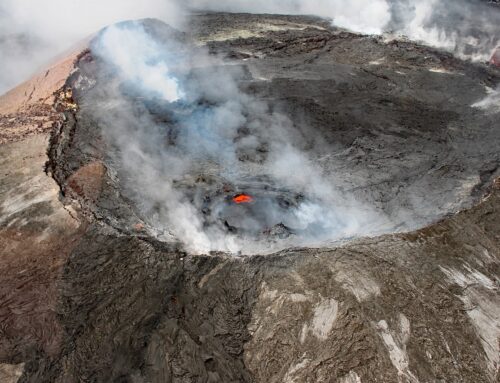


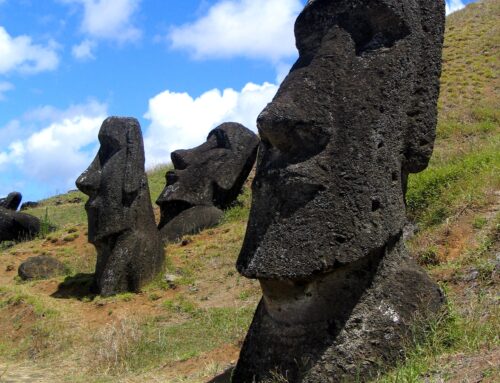

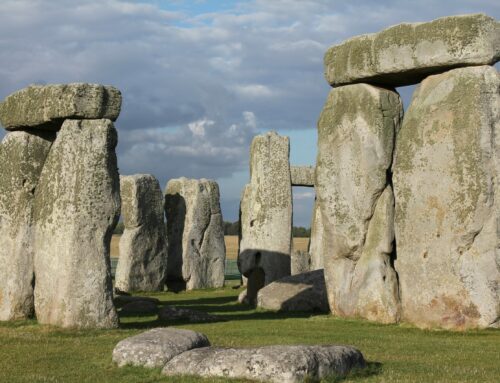
Leave A Comment